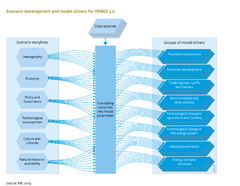Drivers: Difference between revisions
Jump to navigation
Jump to search
No edit summary |
No edit summary |
||
| Line 4: | Line 4: | ||
|ExternalModel=ENV-Growth model; MAGNET model; | |ExternalModel=ENV-Growth model; MAGNET model; | ||
|KeyReference=IPCC, 2000; OECD, 2012; MA, 2005; | |KeyReference=IPCC, 2000; OECD, 2012; MA, 2005; | ||
|Description= | |Description=To explore future scenarios, exogenous assumptions need to be made for a range of factors that shape the direction and rate of change in key model variables and results. Together with the endogenous functional relationships and model parameters that typify model behaviour, these exogenous assumptions drive the outcome of model calculations. These assumptions are the drivers that determine the model results, subject to the assumed external conditions. | ||
In IMAGE, six groups of assumptions are distinguished that make up the scenario drivers. These six groups are the basis for all scenarios and are embedded in a scenario narrative or storyline. This includes cases where current trends and dynamics are assumed to continue into the future, commonly referred to as reference or ‘business-as-usual’ scenarios. But scenario drivers can also be used to describe a set of contrasting future futures to explore the relevant range of uncertain yet plausible developments. | |||
As a rule, scenario drivers are not numerical model inputs but, in qualitative or semi-quantitative terms, govern a detailed set of exogenous assumptions in terms of model input to the various components of the model framework. Numerical model drivers for a specific scenario are established on the basis of the six generic scenario drivers. The model drivers for the various IMAGE models and modules (called components on the site) are explained in the component pages (see [[Framework overview]]) . | |||
The scenario drivers and underlying narrative, together with the quantitative model drivers, form a scenario that is inextricably linked with the results from an IMAGE scenario run. | |||
|ComponentCode=D | |ComponentCode=D | ||
|FrameworkElementType=driver component | |FrameworkElementType=driver component | ||
}} | }} | ||
[[Page has default form::DriverComponentForm| ]] | [[Page has default form::DriverComponentForm| ]] | ||
Revision as of 11:48, 9 May 2014
| Projects/Applications |
| Models/Databases |
| Relevant overviews |
| Key publications |
